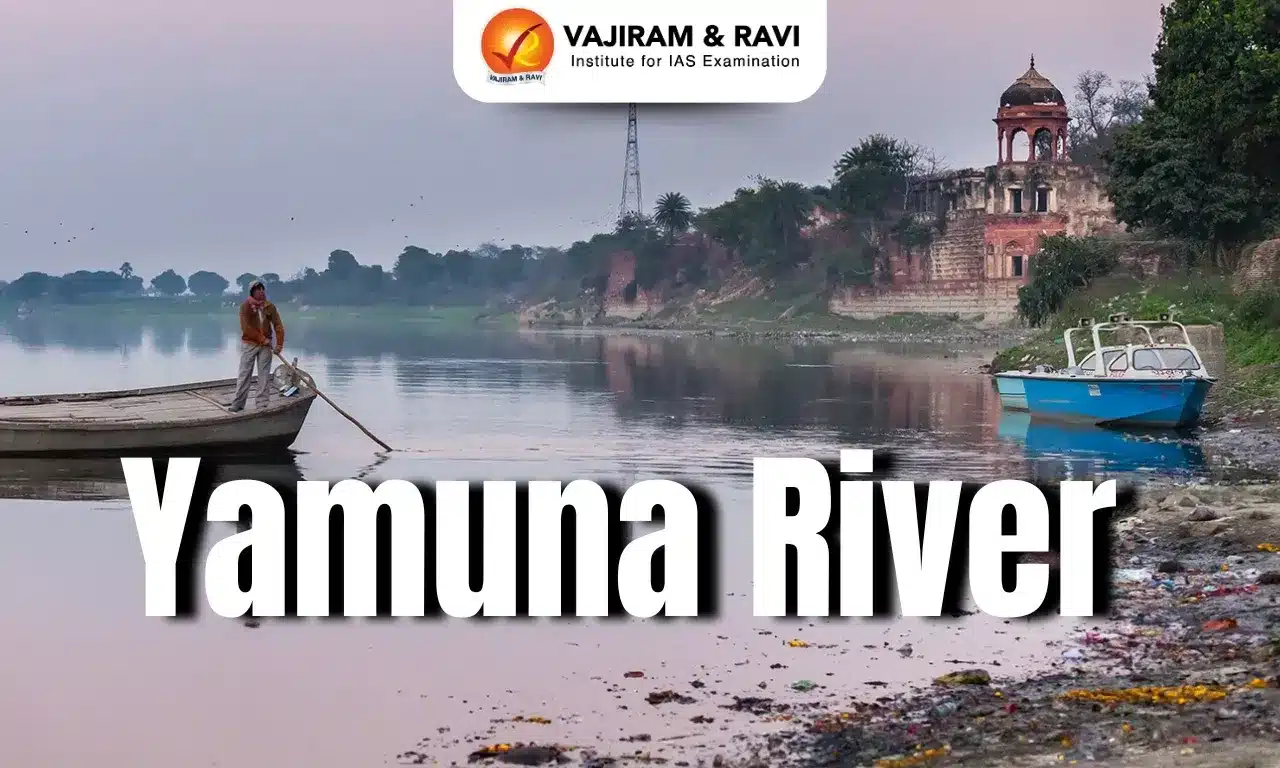Yamuna River Latest News
A large-scale effort to clean the heavily polluted River Yamuna commenced recently, guided by a four-pronged strategy, aimed to restore the river within three years.
About Yamuna River
- Yamuna River (also known as Jumna) is the major tributary of the Ganges River.
- Origin: It rises in the high Himalaya, in the Yamunotri Glacier, at the height of 4,421 meters.
Yamuna River Course
- The 1,376 km long Yamuna flows solely through India, crossing three states: Uttarakhand, Uttar Pradesh, and Haryana.
- After rising in the high himalayas, it flows in a southerly direction swiftly through the Himalayan foothills and, exiting Uttarakhand, onto the Indo-Gangetic Plain, along the border between Uttar Pradesh, and Haryana state to the west. The Eastern and Western Yamuna canals are fed from the river at that point.
- The Yamuna then passes Delhi, where it feeds the Agra Canal.
- South of Delhi, and now wholly within Uttar Pradesh, it turns southeastward.
- Near Prayagraj (Allahabad), after a course of about 855 miles (1,376 km), the Yamuna joins the Ganges River.
- The confluence of the two rivers is an especially sacred place to Hindus and is the site of annual festivals as well as the Kumbh Mela, which is held every 12 years.
Yamuna River Tributaries
- Near Dehradun, the capital city of Uttarakhand, the Yamuna is joined by its biggest tributary, the Tons River.
- The Chambal River is Yamuna’s biggest tributary on the right.
- Other important tributaries of the Yamuna include the Hindon, Sarda, and Giri rivers on the right and Betwa and Sindh on the left.
Yamuna River FAQs
Q1. Where is the Yamuna River located?
Ans. The Yamuna River is located in northern India, flowing through states like Uttarakhand, Haryana, Delhi, and Uttar Pradesh.
Q2. Which city is beside Yamuna River?
Ans. Several cities are situated beside the Yamuna River, including Delhi, Agra, and Allahabad (Prayagraj).
Q3. What is the joining place of Ganga and Yamuna called?
Ans. The joining place of the Ganga and Yamuna rivers is called the Triveni Sangam, located in Prayagraj (Allahabad), Uttar Pradesh.
Source: BS
Last updated on August, 2025
→ UPSC Mains Admit Card 2025 has been released on 14th August at www.upsc.gov.in.
→ UPSC Mains 2025 will be conducted on 22nd August 2025.
→ UPSC Notification 2025 was released on 22nd January 2025.
→ UPSC Calendar 2026 is released on 15th May, 2025.
→ UPSC Prelims Question Paper 2025 and Unofficial Prelims Answer Key 2025 are available now.
→ UPSC Prelims Result 2025 is out now for the CSE held on 25 May 2025.
→ The UPSC Vacancy 2025 were released 1129, out of which 979 were for UPSC CSE and remaining 150 are for UPSC IFoS.
→ UPSC Prelims 2026 will be conducted on 24th May, 2026 & UPSC Mains 2026 will be conducted on 21st August 2026.
→ The UPSC Selection Process is of 3 stages-Prelims, Mains and Interview.
→ UPSC Result 2024 is released with latest UPSC Marksheet 2024. Check Now!
→ UPSC Toppers List 2024 is released now. Shakti Dubey is UPSC AIR 1 2024 Topper.
→ Also check Best IAS Coaching in Delhi















